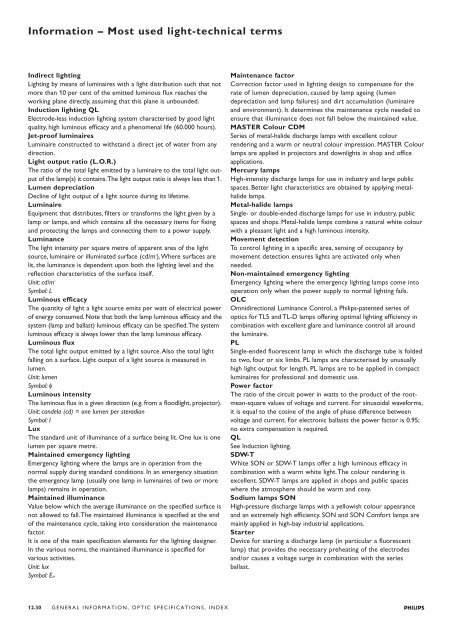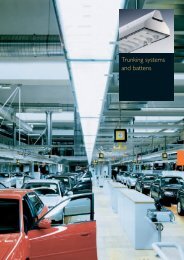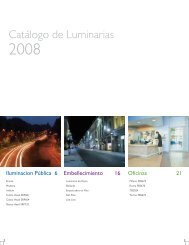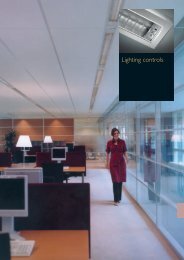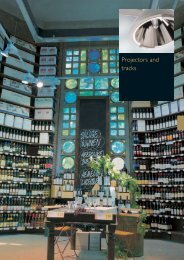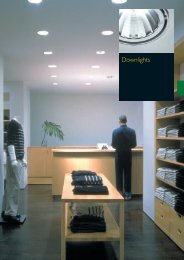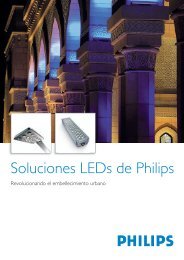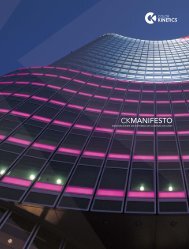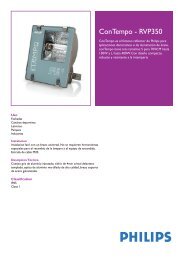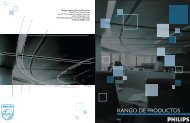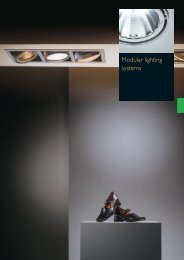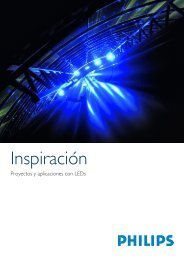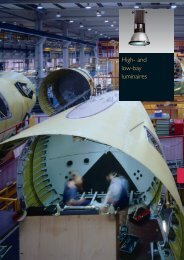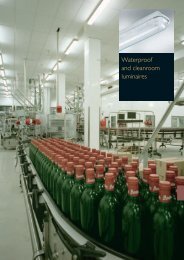General information, optic specifications, index
General information, optic specifications, index
General information, optic specifications, index
Create successful ePaper yourself
Turn your PDF publications into a flip-book with our unique Google optimized e-Paper software.
L968D969_SRC.QXD 11-03-2004 08:26 Pagina 12.30<br />
Information – Most used light-technical terms<br />
Indirect lighting<br />
Lighting by means of luminaires with a light distribution such that not<br />
more than 10 per cent of the emitted luminous flux reaches the<br />
working plane directly, assuming that this plane is unbounded.<br />
Induction lighting QL<br />
Electrode-less induction lighting system characterised by good light<br />
quality, high luminous efficacy and a phenomenal life (60.000 hours).<br />
Jet-proof luminaires<br />
Luminaire constructed to withstand a direct jet of water from any<br />
direction.<br />
Light output ratio (L.O.R.)<br />
The ratio of the total light emitted by a luminaire to the total light output<br />
of the lamp(s) it contains.The light output ratio is always less than 1.<br />
Lumen depreciation<br />
Decline of light output of a light source during its lifetime.<br />
Luminaire<br />
Equipment that distributes, filters or transforms the light given by a<br />
lamp or lamps, and which contains all the necessary items for fixing<br />
and protecting the lamps and connecting them to a power supply.<br />
Luminance<br />
The light intensity per square metre of apparent area of the light<br />
source, luminaire or illuminated surface (cd/m 2<br />
).Where surfaces are<br />
lit, the luminance is dependent upon both the lighting level and the<br />
reflection characteristics of the surface itself.<br />
Unit: cd/m 2<br />
Symbol: L<br />
Luminous efficacy<br />
The quantity of light a light source emits per watt of electrical power<br />
of energy consumed. Note that both the lamp luminous efficacy and the<br />
system (lamp and ballast) luminous efficacy can be specified.The system<br />
luminous efficacy is always lower than the lamp luminous efficacy.<br />
Luminous flux<br />
The total light output emitted by a light source.Also the total light<br />
falling on a surface. Light output of a light source is measured in<br />
lumen.<br />
Unit: lumen<br />
Symbol:<br />
Luminous intensity<br />
The luminous flux in a given direction (e.g. from a floodlight, projector).<br />
Unit: candela (cd) = one lumen per steradian<br />
Symbol: I<br />
Lux<br />
The standard unit of illuminance of a surface being lit. One lux is one<br />
lumen per square metre.<br />
Maintained emergency lighting<br />
Emergency lighting where the lamps are in operation from the<br />
normal supply during standard conditions. In an emergency situation<br />
the emergency lamp (usually one lamp in luminaires of two or more<br />
lamps) remains in operation.<br />
Maintained illuminance<br />
Value below which the average illuminance on the specified surface is<br />
not allowed to fall.The maintained illuminance is specified at the end<br />
of the maintenance cycle, taking into consideration the maintenance<br />
factor.<br />
It is one of the main specification elements for the lighting designer.<br />
In the various norms, the maintained illuminance is specified for<br />
various activities.<br />
Unit: lux<br />
Symbol: Em<br />
12.30 GENERAL INFORMATION, OPTIC SPECIFICATIONS, INDEX<br />
Maintenance factor<br />
Correction factor used in lighting design to compensate for the<br />
rate of lumen depreciation, caused by lamp ageing (lumen<br />
depreciation and lamp failures) and dirt accumulation (luminaire<br />
and environment). It determines the maintenance cycle needed to<br />
ensure that illuminance does not fall below the maintained value.<br />
MASTER Colour CDM<br />
Series of metal-halide discharge lamps with excellent colour<br />
rendering and a warm or neutral colour impression. MASTER Colour<br />
lamps are applied in projectors and downlights in shop and office<br />
applications.<br />
Mercury lamps<br />
High-intensity discharge lamps for use in industry and large public<br />
spaces. Better light characteristics are obtained by applying metalhalide<br />
lamps.<br />
Metal-halide lamps<br />
Single- or double-ended discharge lamps for use in industry, public<br />
spaces and shops. Metal-halide lamps combine a natural white colour<br />
with a pleasant light and a high luminous intensity.<br />
Movement detection<br />
To control lighting in a specific area, sensing of occupancy by<br />
movement detection ensures lights are activated only when<br />
needed.<br />
Non-maintained emergency lighting<br />
Emergency lighting where the emergency lighting lamps come into<br />
operation only when the power supply to normal lighting fails.<br />
OLC<br />
Omnidirectional Luminance Control, a Philips-patented series of<br />
<strong>optic</strong>s for TL5 and TL-D lamps offering optimal lighting efficiency in<br />
combination with excellent glare and luminance control all around<br />
the luminaire.<br />
PL<br />
Single-ended fluorescent lamp in which the discharge tube is folded<br />
to two, four or six limbs. PL lamps are characterised by unusually<br />
high light output for length. PL lamps are to be applied in compact<br />
luminaires for professional and domestic use.<br />
Power factor<br />
The ratio of the circuit power in watts to the product of the rootmean-square<br />
values of voltage and current. For sinusoidal waveforms,<br />
it is equal to the cosine of the angle of phase difference between<br />
voltage and current. For electronic ballasts the power factor is 0.95;<br />
no extra compensation is required.<br />
QL<br />
See Induction lighting.<br />
SDW-T<br />
White SON or SDW-T lamps offer a high luminous efficacy in<br />
combination with a warm white light.The colour rendering is<br />
excellent. SDW-T lamps are applied in shops and public spaces<br />
where the atmosphere should be warm and cosy.<br />
Sodium lamps SON<br />
High-pressure discharge lamps with a yellowish colour appearance<br />
and an extremely high efficiency. SON and SON Comfort lamps are<br />
mainly applied in high-bay industrial applications.<br />
Starter<br />
Device for starting a discharge lamp (in particular a fluorescent<br />
lamp) that provides the necessary preheating of the electrodes<br />
and/or causes a voltage surge in combination with the series<br />
ballast.


